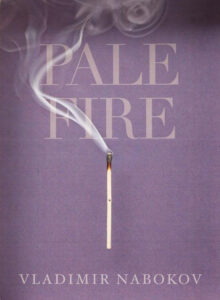Each month, we ask a member of faculty to tell us about one book that played an outsized role in making them who they are today. This month’s contribution to Words to Live By, by Assistant Professor of Humanities, Dr. Daniel Brandes, introduced him to a level of literature he believes he may never again encounter.

I’m happy for the chance to recommend (and reflect on) Vladimir Nabokov’s Pale Fire, the master’s masterpiece, and the book that has brought me more visceral and intellectual pleasure than any other. While casual Nabokov readers (if there are such, somehow) might single out Lolita as his best work, true devotees know that he reached the peak of his powers with this fantastic fictional hall of mirrors. In his Lectures on Literature, Nabokov famously claimed that one reads with the spine or not at all: “Although we read with our minds, the seat of artistic delight is between the shoulder blades. That little shiver behind is quite certainly the highest form of emotion that humanity has attained when evolving pure art and pure science. Let us worship the spine and its tingle.” Pound for pound, there is more tingle in this resplendent book than any five books by [name X author here].
 I first came across Pale Firebook as an undergraduate at the University of Toronto, where I was trying not to buckle under an exclusively German diet of Hegel, Heidegger and Arendt. The book was a tonic. Opening with the final production of the reclusive poet-professor, John Shade —“a poem in heroic couplets, of nine-hundred ninety-nine lines, divided into four cantos”—the bulk of the book is taken up by the brilliant and self-infatuated commentary on this poem produced by Shade’s mysterious neighbour, Dr. Charles Kinbote, who discovers in the poem an allegory of his own childhood and aristocratic upbringing in the faraway Kingdom of Zembla. It is impossible to capture in summary the vast intricacy and hilarity of Kinbote’s interpretation (he is a far better writer than Shade himself), so I’ll simply say that the entire work—poem and commentary—is a creation of perfect beauty. It was the best thing I read at university, and I’ve returned to it maybe 10 times since then. I should add that there is a booming cottage industry of scholarship devoted to the question of where Shade ends and Kinbote begins, who ‘really’ wrote the poem, and what role ought to be assigned to Shade’s wife (antagonist of Kinbote), his lost daughter (the ostensible subject of the mournful poem), and his own poetic vocation. I lapped all of this up; it was my escape from heavy metaphysics, and it probably delayed early onset baldness for the sheer delight it provided.
I first came across Pale Firebook as an undergraduate at the University of Toronto, where I was trying not to buckle under an exclusively German diet of Hegel, Heidegger and Arendt. The book was a tonic. Opening with the final production of the reclusive poet-professor, John Shade —“a poem in heroic couplets, of nine-hundred ninety-nine lines, divided into four cantos”—the bulk of the book is taken up by the brilliant and self-infatuated commentary on this poem produced by Shade’s mysterious neighbour, Dr. Charles Kinbote, who discovers in the poem an allegory of his own childhood and aristocratic upbringing in the faraway Kingdom of Zembla. It is impossible to capture in summary the vast intricacy and hilarity of Kinbote’s interpretation (he is a far better writer than Shade himself), so I’ll simply say that the entire work—poem and commentary—is a creation of perfect beauty. It was the best thing I read at university, and I’ve returned to it maybe 10 times since then. I should add that there is a booming cottage industry of scholarship devoted to the question of where Shade ends and Kinbote begins, who ‘really’ wrote the poem, and what role ought to be assigned to Shade’s wife (antagonist of Kinbote), his lost daughter (the ostensible subject of the mournful poem), and his own poetic vocation. I lapped all of this up; it was my escape from heavy metaphysics, and it probably delayed early onset baldness for the sheer delight it provided.
How has the book shaped me? It’s made me an insufferable snob. Because I have not, and likely will not, encounter anything in fiction to rival this gem, and because I lack the good taste to keep it to myself, I now spend my time casting disdainful judgments on the pet favourites of others and making myself unpleasant in mixed company. On the upside, it has also provided me with more interpretive thrills than anything this side of the Talmud. So… fair trade.

